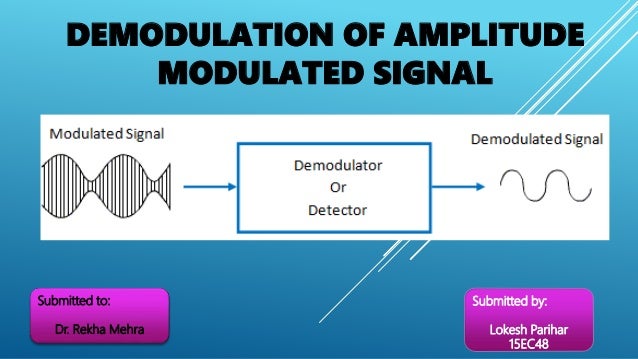The modulation is extracted from the incoming overall received signal. Demodulation is the process by which the original information bearing signal ie.
Very few would consider it as analog transmission.

Demodulation definition and uses. The term demodulator is used because the demodulation process is considered to be the opposite of modulation. It has the exact same intent to remove the carrier signal and reconstruct the signal envelope. In a radio telephony channel it may suffice at the receiver site to get an.
A noncoherent detector has. Demodulation synonyms demodulation pronunciation demodulation translation English dictionary definition of demodulation. Once the signal has been received filtered and amplified it is necessary to recover the original modulation from the carrier.
The conversion of a modulated carrier wave into a current equivalent to the original signal. Electronics the act or process by which an output wave or signal is obtained having the characteristics of the original modulating wave or signal. This is an advantage over FD-OCT techniques which are described in the next chapter.
Information and translations of demodulation in the most comprehensive dictionary definitions resource on the web. The scope of the demodulation depends on the type of data being send. A device used in demodulation Meaning pronunciation translations and examples.
This detector is primarily used in TV demodulation and is used in some FM radio stations. The functional and morphologic fluctuation of cells in response to changing environmental conditions. FM demodulation is a key process in the reception of a frequency modulated signal.
On the flipside we have demodulation which takes an analog signal and turns it back into a digital signal that can be. According to another definition the modulation is a form of digital-to-analog conversion. Demodulation is defined as extracting the original information-carrying signal from a modulated carrier wave.
The circuit in which restoration is achieved is called the DETECTOR or DEMODULATOR both of these terms are used in NEETS. Where as a demodulator is an circuitry that is utilized to recover original information or data from the modulated signal. The output section demodulates the signal restores it to the original analog input equivalent and filters the ripple component which resulted from the demodulation process.
Modulation is the process of turning a digital signal sent from the sending computer into an analog signal so that it can be transmitted as electrical pulses. There are different types of modulation and so are demodulators. FM Demodulator Classification Coherent Non-coherent A coherent detector has two inputsone for a reference signal such as the synchronized oscillator signal and one for the modulated signal that is to be demodulated.
What is Demodulation. The reverse of modulation. Though coined during the development of radio technology they sound intuitively correct for ultrasound as well.
Modulation is the process of encoding information in a transmitted signal while demodulation is the process of extracting information from the transmitted signal. Many factors influence how faithfully the extracted information replicates the original input information. A demodulator is an electronic circuit that is mainly used to recover the information content from the modulated carrier wave.
The output of an ideal detector must be an exact reproduction of the modulation existing on the rf wave. With TD-OCT the signal passes through demodulation logarithmic amplifiers which compress the data and make the large SNR signal more assessable. It uses a phase-shift circuit to produce a phase shift of 90 at the unmodulated carrier frequency.
It is this process that is called demodulation or detection. Demodulation is the reverse process of again recovering the original message. To perform the demodulation an internal counter is used to determine the frequency of the incoming signal.
According to one definition of digital signal the modulated signal is a digital signal. Transmission through the channel in consideration. In general amplitude modulation definition is given as a type of modulation where the amplitude of the carrier wave is varied in some proportion with respect to the modulating data or the signal.
As for the mechanism when amplitude modulation is used there is a variation in the amplitude of the carrier. The primary purpose of demodulation is to remove the carrier frequency Doppler shift. Systematic variation in a characteristic for example frequency amplitude of a sustained oscillation to code additional information.
Demodulation is a key process in the reception of any amplitude modulated signals whether used for broadcast or two way radio communication systems. Demodulation is the process of separating information from a modulated carrier wave. What demodulator is used for FM.
For this reason the process is often called demodulation or detection. What does demodulation mean. Most textbooks would consider digital modulation schemes as a form of digital transmission synonymous to data transmission.
Quadrature Detectors Quadrature Detectors The quadrature detector is probably the single most widely used FM demodulator. Demodulation is basically extracting the original information carrying signal from a carrier wave.

Modulation And Demodulation Working Types Of Modulation Examples

Modulation And Demodulation In Urdu And Hindi Academy Khi

Modulation Demodulation Amplitude Frequency Communication System Part 4 In Hindi Youtube

What Is Modulation And Demodulation Definition Types Differences Video And Faqs

Modulation And Demodulation Detailed Explanation Information Palace